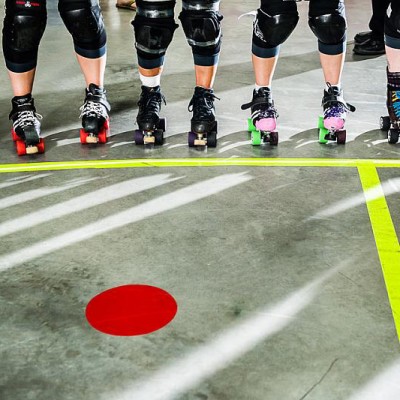
In the last post, we learned about the importance of Goal Setting, and how it can impact our mental game. Goal setting allows you to create your mission statement – what it is you want to achieve this upcoming season. Goals can give you direction and, allow you to focus your attention on key elements in your performance.
As I mentioned before, goal setting can be compared to climbing a mountain. The goal is to reach the peak and hoist up your flag. Climbing a mountain is a challenging task, so you need to be passionate about the journey you’ll be taking. Your passion is driven by your Dream Goal (the flag on the peak). The peak itself represents the long-term performance goals you want to achieve. Achieving these goals will bring you closer to your Dream Goal. Last post I had you create a SMART Dream Goal (outcome goal), and some SMART Long-Term Performance Goals. Now that you know the mountain you want climb, it’s time to look at the journey you’ll need to take.
Mapping Your Journey with Performance Goals
Getting to the top of the mountain never happens in one step, otherwise we would all be climbing Mt. Everest! You know where you want to go, now it’s time to plan your journey. When it comes to goal setting, it’s easier to work your way backwards: from the top to the bottom.
From your Long-Term Performance Goals, you’ll be able to create mid-term and short-term performance goals. Remember that performance goals focus on achieving standards based on your previous performances. These types of goals move away from outcomes and focus on what you can do!
Example:
If your Long-Term Performance Goal is “I will average 6 points per jam in a game by September 2017” then your Mid-Term and Short-Term goals could be the following:
- “I will average 5 points per jam in a game by July 2017” (Mid-Term Performance Goal)
- “I will average 4 points per jam in a game by April 2017” (Short-Term Performance Goal)
If your long-term performance goal is “I will get 2 penalties or less per game by September 2017” then your Mid-Term and Short-Term goals could be the following:
- “I will average 3 penalties or less per game by July 2017” (Mid-Term Performance Goal)
- “I will average 4 penalties or less per game by April 2017” (Short-Term Performance Goal)
There should be a link between your Short-Term, Mid-Term, and Long-Term Performance Goals. You’ll be creating smaller, more achievable steps as you progress up the mountain. If you’re averaging 5-6 penalties a game, it will seem almost impossible to drop to 1-2 penalties immediately. By breaking up your performance goals, you’re no longer starting from the bottom of the mountain and making a full climb to the top in one shot. Instead you’re creating markers that will allow you to track your progress. If you think back to the metaphor of climbing a mountain, these markers are check points. Now that your journey is mapped out, you can work towards reaching these performance goals through Process Goals.
Taking Action with Process Goals
Process Goals target specific behaviors or actions that you want to improve or change. Basically, Process Goals are about WHAT you need to work on and HOW it will be done. Thinking back to the metaphor, these Process Goals are represented in each step that we take to make it to the next check point.
Look at your short-term performance goals, what do you need to do to work on achieving your goal? In order to figure that out, you need to know where you stand today, with that particular Performance Goal. This is where self-awareness comes into play. If your short-term performance goal is “I will average 4 points per jam in a game by April 2017” and as of today, you are averaging 2 points per jam, then you need to know what skills are you lacking or what needs to be improved in order to change your points/jam average.
Example:
Your Short-Term Performance goal is “I will average 4 penalties or less per game by April 2017”. One of your smart process goals could be:
- “In February 2017, I will cross train 3 times a week to improve my core strength to improve my stability and control”
One Short-Term Goal can lead to multiple Process Goals. Process Goals can be placed in a monthly, weekly, or daily timeline. No matter what you choose, remember that tracking and monitoring your progress with these process goals is important. You need to see the changes that you are making. These small steps might seem insignificant at times, but when you look at the entire climb up the mountain it couldn’t have been done without them. Get in the habit of asking yourself “What can I do today that will bring me one step closer to my goals?”
Some Goal Setting Tips
1. Don’t set too many goals, especially in a short time period
You need to be able to monitor and track your progress without feeling overwhelmed. If you can’t keep track of all your goals, some of the goals will slip through the cracks. Keep it simple.
2. Positive goals rather than negative goals
Make sure that your goals are written in a positive manner. You want to focus on the areas you want to improve – not put attention on negative behaviors that you want to reduce.
3. Write your goals down and make them visible
The act of writing your goals makes them concrete. It’s no longer just the thought of what you’d like to achieve, it becomes a mission statement on what you will achieve. It’s common to feel committed to your goals as you’re writing them. Sadly, if you don’t place your goals in a visible spot they can be forgotten.
4. Reflect and adjust your goals
Goal setting is not a one-time event. You need to make adjustments in order to adapt to your individual needs and to your progress.
When it comes to goal setting, there’s a difference between planning and implementing and evaluating. That being said, I don’t want you to forget about your goals. Remember that goal setting is a journey not a quick fix, so I’ll be checking in with you a few months down the line. Hopefully you’re making progress one step at a time.
Stay positive and remind yourself of your dream to keep you motivated!

 Stop sucking. Start winning.
Stop sucking. Start winning.  PreHab: How to Reduce Concussions
PreHab: How to Reduce Concussions  Prehab! Feet and Ankles
Prehab! Feet and Ankles  Cross-Training for Roller Derby: A Primer
Cross-Training for Roller Derby: A Primer  Fresh Meat – You Got This!
Fresh Meat – You Got This!